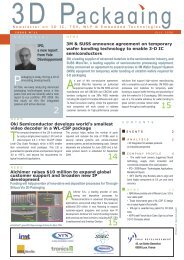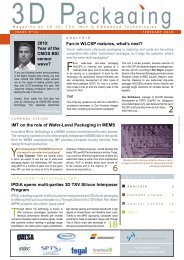September 2011 - I-Micronews
September 2011 - I-Micronews
September 2011 - I-Micronews
You also want an ePaper? Increase the reach of your titles
YUMPU automatically turns print PDFs into web optimized ePapers that Google loves.
S E P T E M B E R 2 0 1 1 I S S U E N ° 1 3<br />
“Compared to the<br />
more established<br />
flat plate PV<br />
technology, HCPV<br />
likely has much<br />
more headroom<br />
for improving<br />
efficiency<br />
and cost,”<br />
says Milan Rosina,<br />
Yole Développement.<br />
throw at the work. Garboushian ticks off potential<br />
ways to gain a few percentage points improvement<br />
across almost all the various components in the<br />
systems - from better multijunction cell efficiency, to<br />
better pitch angles and more accurate facets in the<br />
Fresnel lenses, up through more accurate alignment<br />
in the balance of systems, which could together<br />
perhaps add up to as much as 50% improvement<br />
overall.<br />
Key to much of this improvement is the growth and<br />
increasing maturity of the supply chain. “While the<br />
solar supply chain continues to mature, there has<br />
been no shortage of innovation,” he says, noting that<br />
the optics and components are constantly improving.<br />
On the cell side, Garboushian notes that the best<br />
cells are already 5% to 10% better than those<br />
from some other suppliers, and spectral tuning for<br />
particular locations can add up to another 5% to 10%<br />
improvement in energy generation. But going beyond<br />
three junction cells won’t be an easy step for the<br />
optics and the rest of the system.<br />
Garboushian and Amonix have been making<br />
concentrating solar for some 20 years, and were<br />
among the pioneers of the big move from silicon to<br />
compound semiconductor triple junction cells for the<br />
boost in efficiency that did much to help create a viable<br />
HCPV market not so very long ago. The company’s<br />
early 7.8 MW-scale HCPV project with Guascor<br />
Foton in Spain in 2006-2008 used silicon cells, and<br />
depended on European government subsidies to be<br />
economic. Working with Emcore and Spectrolab to<br />
stabilize the process, prove the cell reliability, and<br />
redesign the rest of the system took a year, but it cut<br />
costs roughly in half and enabled output to jump from<br />
25kW to 37kW.<br />
SolFocus permitting 30MW project, plans<br />
to double production capacity to 100MW<br />
SolFocus is stepping up to tens-of-megawatt projects<br />
as well, with a 30MW power supply agreement<br />
from San Diego Gas & Electric now in the permitting<br />
process, which may be ready to start installation later<br />
this year. Nancy Hartsoch, VP of marketing, says the<br />
company also plans to increase its production capacity<br />
from the current 50MW to 100MW this year, by adding<br />
a second $10 million robotic assembly cell at its<br />
assembly facilities in China.<br />
The San Jose, California, company has installed<br />
projects in a dozen countries, most so far relatively<br />
small, essentially to test the HCPV performance<br />
under various conditions at different sites around the<br />
world. Recent larger US installations include the 1MW<br />
Victor Valley College project, the 1MW Nichols Farm<br />
pistachio processing plant, and the ~0.5MW Coachilla<br />
water reclamation plant, the latter two particularly<br />
significant because they were put together by heavy<br />
weight project managers Bechtel and Johnson<br />
Controls, suggesting these big companies think it<br />
worthwhile to learn the HCPV business on these<br />
relatively small installations for its future potential.<br />
Another big step: the first performance warranty<br />
insurance for HCPV from Munich Re.<br />
Though the utility market will be the bigger one,<br />
Hartsoch also sees a strong market for HCPV in this<br />
type of distributed generation, for the educational,<br />
agricultural processing, and water treatment markets,<br />
all users that tend to have big electrical bills, extra<br />
land already, and renewable energy goals.<br />
Like most of the other companies in this young<br />
technology, SolFocus designed and originally made<br />
not only its own components, but even much of its<br />
custom production equipment, but as volume has<br />
increased, it has outsourced all production. The<br />
company’s founders decided from the beginning to<br />
focus on proven glass, aluminum and steel materials,<br />
and on designing for manufacturability as the best<br />
way to create a low cost product. Major parabolic<br />
dish glass supplier Flabeg makes the mirrors, using<br />
SolFocus-designed equipment to slump a square<br />
mirror. One of the big electronics assembly houses<br />
assembles the receiver units and optical cones, and<br />
an assembly company in China puts together the final<br />
systems, using a monster press to stamp out the<br />
backpan in one piece, and a three-robot cell designed<br />
to SolFocus specifications by a company from the<br />
automotive assembly industry.<br />
Hartsoch argues that the company’s unique optics<br />
design may add complexity, with its third non-imaging<br />
optic that focuses the light down through a prism to<br />
more evenly illuminate the cell, the unusually wide<br />
1.6° acceptance angle allows more margin for some<br />
misalignment in assembly, installation and tracking.<br />
“You can lose a lot of energy for every 0.25° smaller<br />
acceptance angle,” she argues.<br />
The new generation systems just introduced swap out<br />
the cells for the next generation of more efficient ones,<br />
to boost panel efficiency to 29%, and redesign the<br />
modules for easier field assembly to reportedly reduce<br />
installation costs by cutting field installation time by<br />
half. The new modules add more panels per tracker,<br />
for fewer total trackers, and pre-assemble more panels<br />
into units, for fewer units per tracker to install, and no<br />
need for alignment in the field. The electronics are also<br />
now premounted on the tracker head, so no electronics<br />
assembly is required in the field. Hartsoch says that cut<br />
field assembly time in half. “And that’s with engineers,”<br />
she quips. “In the field with construction people it<br />
should be more than a 50% reduction in assembly<br />
time.” The relatively light dish units can be installed<br />
with cranes or scaffold forklifts, and can go on spread<br />
foundations or steel piers instead of concrete and in<br />
problematic soils like sand or landfills.<br />
6<br />
P V M a n u f a c t u r i n g
















